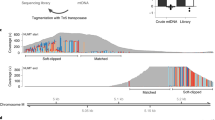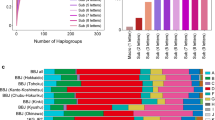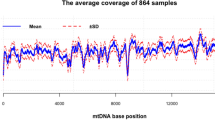Abstract
Evidences are accumulating on the effects of the variability of mitochondrial DNA (mtDNA) on many complex traits. In particular, mtDNA haplogroup J has been reported to increase the individual chance to attain longevity in northern Italians, Northern Irish and Finns. However, since the genetic contribution to longevity may be population specific, we wanted to verify if haplogroup J does affect longevity also in a southern European population having a different genetic and environmental history. We analysed a population sample (883 subjects, 371 males and 521 females; age range 18–108 years) from southern Italy for the presence of haplogroup J. No frequency increase of this mtDNA haplogroup was found in the older cohorts, suggesting that, in this population, haplogroup J does not play a significant role in longevity. This finding shows that, as for other genetic factors, the association of mtDNA inherited variability with longevity is population specific.
Similar content being viewed by others
Introduction
The influence of mitochondrial DNA (mtDNA) variability on longevity has been highlighted by many evidences, on both humans and model organisms. As to humans, it has been proposed that some common mtDNA polymorphisms, probably affecting the efficiency of mitochondrial processes (oxidative phosphorylation) and the complex interaction between mitochondria and nucleus, could affect the individual rate of ageing and longevity1 (and references therein). The Caucasian haplogroup J (characterized by the mutations T489C, A10398G, A12612G, G13708A plus the T4216C, A11251G and C15452A substitutions shared with haplogroup T) seems to confer a higher chance to attain longevity than other mtDNA haplogroups. In fact, three independent studies have shown that haplogroup J is over-represented in groups of centenarians with respect to geographically matched younger controls in northern Italy,2 Northern Ireland3 and Finland.4 Similarly, in the Japanese population, the C5178A transversion (characterizing the Asian haplogroup D) was reported to be associated with longevity, being more frequent in centenarians than in a control group of younger subjects.5 The association between haplogroup D and longevity has not been found in southern Chinese.6 This is likely to be due to the absence of oldest old persons in the Chinese sample (maximum age 75 years); however, we cannot exclude that the association between haplogroup D and longevity is specific of the Japanese population, and thus absent in the Chinese group. Indeed, the mitochondrial genome is highly variable, and a continent-specific haplogroup may include mtDNA mutations that only occur in a specific ethnic group. What is more, genetic and environmental background can influence the effect of mtDNA mutations on a complex trait, such as longevity7 (and references therein).
On the basis of these considerations, we wanted to verify if the association of haplogroup J with longevity we observed in northern Italians does occur also in a population from southern Italy (Calabrians). Indeed, the genetic history differs between southern and northern Italian populations;8 furthermore, southern Italians experienced a different environment with respect to the central-northern European populations, where the association between haplogroup J and longevity has been reported.
Materials and methods
We typed for the presence/absence of the J haplogroup a sample of 883 subjects (371 males and 521 females) whose ages ranged between 18 and 108 years. All the subjects were of ascertained Calabrian ancestry up to the second generation and each of them – after an explanation of the studies carried out by our laboratory – signed a written consent before being recruited. Details on the recruitment strategies are given elsewhere.9
The DNA analyses to ascertain the J-haplogroup mutations are decribed in a previous report.2
To figure out the age-related frequency trajectories of J haplogroup, a straight line y=β0+β1x was fitted to the relevant frequency data observed in five age classes (18–40; 41–55; 56–70; 71–85 and ≥86 years), thus obtaining estimates b0 and b1 of β0 and β1, respectively. The mean of the ages of individuals belonging to each age class was taken as the x value for that class. Thousand replicates of b0 and b1 were generated by the bootstrap method, from which the empirical distributions of β0 and β1 were obtained, allowing statements to be made about the age-related frequency trajectory. The ascending or descending trend of age-related trajectories was considered significant if the empirical 95% confidence interval (c.i.) of β1 did not include the zero value. The computations were performed by using MATLAB Statistical Toolbox.
Results and discussion
The frequency of haplogroup J in the whole sample turned out to be in line with other studies carried out in European populations (9.3±0.9%). Then the frequency trajectory of J was analysed as a function of age. Figure 1 shows the results in males (Figure 1a) and females (Figure 1b). The linear decreasing trend was not significant either in males (b1=−0.0006, 95% confidence interval [0.0019÷0.0006]) or in females (b1=−0.0004, 95% confidence interval [−0.0013÷0.0005]), showing no age-related frequency increase of J haplogroup.
Age-related frequency trajectory of mtDNA haplogroup J in males (a) and females (b). The linear decreasing trend was not significant either in males (b1=−0.0006, with an estimated 95% confidence interval [−0.0019÷0.0006]) or in females (b1=−0.0004, with an estimated 95% confidence interval [−0.0013÷0.0005]). The number of male (M) and female (F) cases in each age class were the following: 81 M, 131 F (18–40 years); 66 M, 53 F (41–55 years); 103 M, 106 F (56–70 years); 71 M, 117 F (71–85 years); 50 M, 105 F (≥86 years).
The absence of association of mtDNA haplogorup J with longevity in a southern Italian population, after that this association has been reported in three independent studies in northern Europeans, suggests that the influence of mtDNA variability on longevity is population specific. It is important to mention that the mtDNA haplogroup J, which is believed to have entered Europe about 10 000 years ago from the Near East, is characterized by a low efficiency of oxidative phosphorylation.1 This may favour the onset of either complex diseases or longevity, according to the genetic background of the carriers.7 It has been proposed that a low efficiency of oxidative phosphorylation leads to a waste of heat which represents an advantage in the cold climate of northern Europe;10, 11 on turn, the cold climate of northern Europe seems to have favoured the accumulation of further mutations10 emphasizing this feature of the J molecules. Therefore, the population-specific association of mtDNA haplogroup J with longevity may be due to population-specific genetic backgrounds, to particular interactions between haplogroup J and different environments, and/or to diversity of the J molecules between northern and southern European populations. To get insights on the last point, we characterized for the C150 T mutation molecules of haplogroup J in centenarians from northern and southern Italy. The C150 T mutation, which switches the origin of replication of mtDNA molecule, has been found to be more frequent in centenarians' lymphocytes than in younger controls and seems therefore to favour longevity.12 Interestingly, the presence of this mutation in lymphocytes can be due either to inheritance or to accumulation of tissue-specific somatic mutations which are controlled by the nuclear genome. We found that five out of nine centenarians from northern Italy were homoplasmic for the T variant, while only one out of six southern Italian centenarians had the T mutation, thus supporting the idea that the J haplogroup includes different mtDNA molecules in southern and northern Italy and/or interacts with different nuclear backgrounds.
References
Coskun PE, Ruiz-Pesini E, Wallace DC : Control region mtDNA variants: longevity, climatic adaptation, and a forensic conundrum. Proc Natl Acad Sci USA 2003; 100: 2174–2176.
De Benedictis G, Rose G, Carrieri G et al: Mitochondrial DNA inherited variants are associated with successful aging and longevity in humans. FASEB J 1999; 13: 1532–1536.
Ross OA, McCormack R, Curran MD et al: Mitochondrial DNA polymorphism: its role in longevity of the Irish population. Exp Gerontol 2001; 36: 1161–1178.
Niemi AK, Hervonen A, Hurme M, Karhunen PJ, Jylha M, Majamaa K : Mitochondrial DNA polymorphisms associated with longevity in a Finnish population. Hum Genet 2003; 112: 29–33.
Tanaka M, Gong JS, Zhang J, Yoneda M, Yagi K : Mitochondrial genotype associated with longevity. Lancet 1998; 351: 185–186.
Yao YG, Kong QP, Zhang YP : Mitochondrial DNA 5178A polymorphism and longevity. Hum Genet 2002; 111: 462–463.
Rose G, Passarino G, Franceschi C, De Benedictis G : The variability of the mitochondrial genome in human aging: a key for life and death? Int J Biochem Cell Biol 2002; 34: 1449–1460.
Cavalli Sforza LL, Menozzi P, Piazza A : The history and geography of human genes. Princeton, NJ, USA: Princeton University Press, 1994, pp 277–280.
Garasto S, Rose G, De Rango F et al: The study of APOA1, APOC3 and APOA4 variability in Healthy Ageing people reveals another paradox in the oldest old subjects. Ann Hum Genet 2003; 67: 54–62.
Mishmar D, Ruiz-Pesini E, Golik P et al: Natural selection shaped regional mtDNA variation in humans. Proc Natl Acad Sci USA 2003; 100: 171–176.
Ruiz-Pesini E, Mishmar D, Brandom M, Procaccio V, Wallace DC : Effects of purifying and adaptive selection on regional variation in human mtDNA. Science 2004; 303: 223–226.
Zhang J, Asin-Cayuela J, Fish J, Michikawa Y et al: Strikingly higher frequency in centenarians and twins of mtDNA mutation causing remodeling of replication origin in leukocytes. Proc Natl Acad Sci USA 2003; 100: 1116–1121.
Acknowledgements
The work was supported by EU Contract QLK6-CT-2001-00128 (Project European Challenge for Healthy Ageing, ECHA) and by the FIRB grants from the Italian Ministry of Instruction, University and Scientific Research (Project Identificazione di profili genomici nucleo-mitocondriali nella patogenesi di malattie età-associate. Implicazioni diagnostiche e terapeutiche).
Author information
Authors and Affiliations
Corresponding author
Rights and permissions
About this article
Cite this article
Dato, S., Passarino, G., Rose, G. et al. Association of the mitochondrial DNA haplogroup J with longevity is population specific. Eur J Hum Genet 12, 1080–1082 (2004). https://doi.org/10.1038/sj.ejhg.5201278
Received:
Revised:
Accepted:
Published:
Issue Date:
DOI: https://doi.org/10.1038/sj.ejhg.5201278
Keywords
This article is cited by
-
Mitochondrial genome study in blood of maternally inherited ALS cases
Human Genomics (2023)
-
mtDNA haplogroup A enhances the effect of obesity on the risk of knee OA in a Mexican population
Scientific Reports (2022)
-
Mitochondrial DNA in osteoarthritis disease
Clinical Rheumatology (2020)
-
Mitochondria, its DNA and telomeres in ageing and human population
Biogerontology (2018)
-
MtDNA meta-analysis reveals both phenotype specificity and allele heterogeneity: a model for differential association
Scientific Reports (2017)




